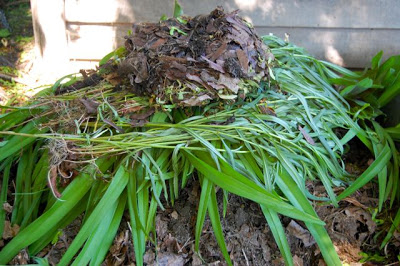My name is Helen, and I am a composter. In fact, I was once the Compost Queen, the kind of girl who stole grass clippings — that had been bagged and left on curbs for the garbage truck. Few things heat
up and speed up a compost pile quite like a layer of grass clippings. But the twice yearly haircuts of my microscopic “lawn” never produced enough.
Leaves and weeds and vegetable kitchen scraps all went into my compost. Eggshells and picked-clean bones, too. In the deep of winter, a growing green ice cube gathered in a garbage can on my back deck, to be turned into the pot come melt. I turned, I aerated. I bent double harvesting the black gold through the composter’s too-small door. It all went into the garden.
Then Toronto introduced its Green Bin organic waste recycling program, and laziness threw my composting ways into a handcart, on its way to hell. My garden has been the worse for it.
Our dad taught me how compost. His method wasn’t fancy, but it was tried and true: the three-pile composting system. To do it, you need an area about 3′ by 9′ — 2′ by 6′ will work if space is tight. Sun or shade.
Pile 1:) Begin by digging Hole A, a shallow depression (3’x3′ or 2’x2′), in the earth. Bung in a few inches of green matter (veggie scraps, weed tops, freshly fallen leaves, &c.), and sprinkle some of the dug earth on top. Soil introduces microorganisms to aid decomposition. Add a little water when things are dry, but don’t let the pile become soggy. Add a layer of green matter as it accumulates and, when you have a few inches, a layer of earth on top.
When your first layers of compost have begun to decompose, turn the pile with a fork and mix it all up to introduce air into the mix. Air is essential for this type of aerobic composting, to make it work and keep your pile smelling fresh. Keep adding layers on top
, sprinkling soil and turning.
Pile 2:) When the stuff in A st
arts to look brown, dig Hole B beside it. Move the compost from A into B. Hole A again becomes the place to put your new compost, layering it with the soil from Hole B.
Whenever you turn the compost in A, turn B as well, adding the chunkier, less-composted bits or brown matter from B back into A. Don’t put anything new into B. Use a garden fork rather than a spade so that the smaller bits or finished compost falls back into the pile.
Pile 3:) Wh
en the stuff from A looks like it’s getting brown, dig a third hole beside B. Move everything from B into Hole C; stuff from A goes into B. Start piling your new compost into A again.
Abracadabra:) You now have three rotating piles: A is always newest and tallest; B is always “cooking”; and pretty soon, the compost from Hole C is ready to add to your garden. Anything that looks unfinished in C goes back into A or B. By this time, the unfinished compost itself contains the microorganisms you originally gained from the soil you dug.
If my description sounds complicated, I apologize. In practice, the three-pile method is, as our dad would have said, dead simple. It’s sort of like that kids’ song, Roll Over, Roll Over. They all rolled over and one fell out: that’s what happens to your compost.
I first composted using this method, then changed to a plastic composter, for cosmetic reasons. However, I believe it [edit to clarify: by “it,” I mean a plastic compost bin] makes compost awkward to turn, slowing the process. It’s also a pain in the back to harvest. Invariably, I ended up yanking the bin off the pile anyway to get at the good stuff. Those spinning barrel composters (like the contraptions lottery numbers are tumbled in) seem smart in principle. In practice, I doubt there’d be enough room for me… or, should I say, for my compost.
After (fruitless) hints to my ingenious husband that a three-bin composter would be a lovely garden project, I have decided to just plunge back in. To quote Voltaire on perfectionism: Le mieux est l’ennemi du bien. The “better” is the enemy of the “good.” (Or, as I have quoted our dad before: Anything worth doing is worth doing badly.) Therefore, I have now created what I will call Pile A, without even bothering to dig a hole! We’ll see what my wantonness gets me.
Once more, vegetable kitchen scraps will be saved for
my home compost pile, but meats and fats a
nd yucky plate scraps will go into the Green Bin to be anaerobically composted by the city.
Unsure whether this decision moves me up or down in the royal hierarchy of composters. My crown feels strangely light, though.





2 comments
I know. I sometimes feel stupid giving all my used teabags to the city, when they could be making my own garden grow better – right here – without the middleman.
When ever I put stuff into my city green bin, I comfort myself by knowing it’s going to a good home…eventually.
Good luck to the compost Queen… Lets see how nature will help breaking down of organic material… ~ bangchik